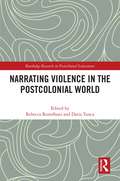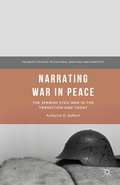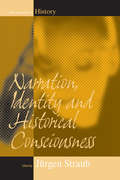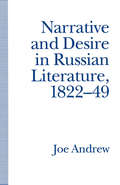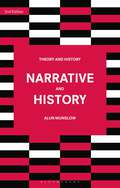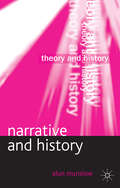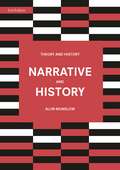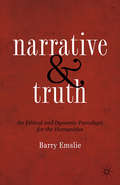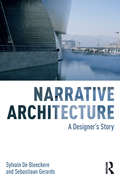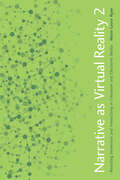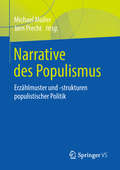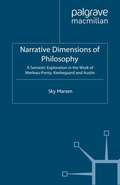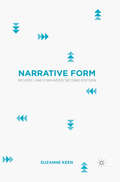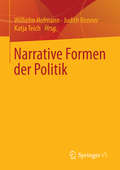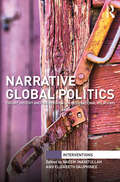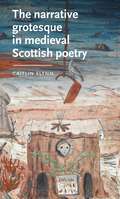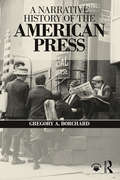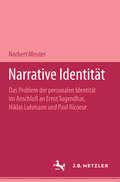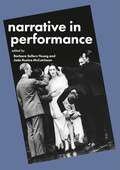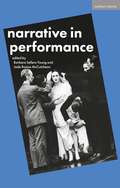- Table View
- List View
Narrating Violence in the Postcolonial World (Routledge Research in Postcolonial Literatures)
by Rebecca Romdhani Daria TuncaThis book examines representations of violence across the postcolonial world—from the Americas to Australia—in novels, short stories, plays, and films. The chapters move from what appear to be interpersonal instances of violence to communal conflicts such as civil war, showing how these acts of violence are specifically rooted in colonial forms of abuse and oppression but constantly move and morph. Taking its cue from theories in such fields as postcolonial, violence, gender, and trauma studies, the book thus shows that violence is slippery in form, but also fluid in nature, so that one must trace its movement across time and space to understand even a single instance of it. When analysing such forms and trajectories of violence in postcolonial creative writing and films, the contributors critically examine the ethical issues involved in narrating abuse, depicting violated bodies, and presenting romanticized resolutions that may conceal other forms of violence.
Narrating Violence in the Postcolonial World (Routledge Research in Postcolonial Literatures)
by Rebecca Romdhani Daria TuncaThis book examines representations of violence across the postcolonial world—from the Americas to Australia—in novels, short stories, plays, and films. The chapters move from what appear to be interpersonal instances of violence to communal conflicts such as civil war, showing how these acts of violence are specifically rooted in colonial forms of abuse and oppression but constantly move and morph. Taking its cue from theories in such fields as postcolonial, violence, gender, and trauma studies, the book thus shows that violence is slippery in form, but also fluid in nature, so that one must trace its movement across time and space to understand even a single instance of it. When analysing such forms and trajectories of violence in postcolonial creative writing and films, the contributors critically examine the ethical issues involved in narrating abuse, depicting violated bodies, and presenting romanticized resolutions that may conceal other forms of violence.
Narrating War in Peace: The Spanish Civil War in the Transition and Today (Palgrave Studies in Cultural Heritage and Conflict)
by Katherine O. StaffordThrough case studies of prominent cultural products, this book takes a longitudinal approach to the influence and conceptualization of the Civil War in democratic Spain. Stafford explores the stories told about the war during the transition to democracy and how these narratives have morphed in light of the polemics about historical memory.
Narration, Identity, and Historical Consciousness (Making Sense of History #3)
by Jürgen StraubA generally acknowledged characteristic of modern life, namely the temporalization of experience, inextricable from our intensified experience of contingency and difference, has until now remained largely outside psychology’s purview. Wherever questions about the development, structure, and function of the concept of time have been posed – for example by Piaget and other founders of genetic structuralism – they have been concerned predominantly with concepts of "physical", chronometrical time, and related concepts (e.g., "velocity"). All the contributions to the present volume attempt to close this gap. A larger number are especially interested in the narration of stories. Overviews of the relevant literature, as well as empirical case studies, appear alongside theoretical and methodological reflections. Most contributions refer to specifically historical phenomena and meaning-constructions. Some touch on the subjects of biographical memory and biographical constructions of reality. Of all the various affinities between the contributions collected here, the most important is their consistent attention to issues of the constitution and representation of temporal experience.
Narrative and History (Theory and History)
by Alun MunslowBased on the assumption that reality, reference and representation work together, this introductory textbook explains and illustrates the various ways in which historians write the past as history. For the first time, the full range of leading narrative theorists such as Paul Ricoeur, Hayden White, Frank Ankersmit, Seymour Chatman and Gérard Genette have been brought together to explain the narrative-making choices all author-historians make when creating historical explanations. Combining theory with practice, Alun Munslow expands the boundaries of the discipline and charts a new role for unconventional historical forms and modes of expression. Clear but comprehensive, this is an ideal resource for undergraduate and postgraduate students taking courses on History and Theory, History and Method, and Historiography.
Narrative and History (Theory and History)
by Alun MunslowBased on the assumption that reality, reference and representation work together, Narrative and History explains and illustrates the various ways in which historians write the past as history. For the fist time, the full range of leading narrative theorists such as Paul Ricoeur, Hayden White, Frank Ankersmit, Seymour Chatman and Gérard Genette have been brought together to explain the narrative-making choices all author-historians make when creating historical explanations.Narrative and History:- considers the range of author-historian decisions through key concepts such as epistemological and aesthetic choice, ethics and ideology, emplotment and argument- defines and illustrates the functions of narrating and narration, authorial voice, characterisation and the timing of the text- explores in detail the consequences for truth, objectivity, meaning, the role of experimental history, and history representation beyond the textual in film, TV, public history, performance and digitization.Combining theory with practice, Alun Munslow expands the boundaries of the discipline and charts a new role for unconventional historical forms and modes of expression.
Narrative and History (Theory and History)
by Alun MunslowBased on the assumption that reality, reference and representation work together, this introductory textbook explains and illustrates the various ways in which historians write the past as history. For the first time, the full range of leading narrative theorists such as Paul Ricoeur, Hayden White, Frank Ankersmit, Seymour Chatman and Gérard Genette have been brought together to explain the narrative-making choices all author-historians make when creating historical explanations. Combining theory with practice, Alun Munslow expands the boundaries of the discipline and charts a new role for unconventional historical forms and modes of expression.Clear but comprehensive, this is an ideal resource for undergraduate and postgraduate students taking courses on history and theory, history and method, and historiography.
Narrative and Truth: An Ethical and Dynamic Paradigm for the Humanities
by Barry EmslieIn this book, Emslie establishes that narrative explanations are to be preferred over non-narrative in the humanities. They are more truthful in two senses. They both correspond more closely to reality and allow inference as to normative values. This is particularly the case when aesthetics are added to the mix.
Narrative Architecture: A Designer's Story
by Sylvain De Bleeckere Sebastiaan GerardsNarrative Architecture explores the postmodern concept of narrative architecture from four perspectives: thinking, imagining, educating, and designing, to give you an original view on our postmodern era and architectural culture. Authors Sylvain De Bleeckere and Sebastiaan Gerards outline the ideas of thinkers, such as Edmund Husserl, Paul Ricoeur, Emmanuel Levinas, and Peter Sloterdijk, and explore important work of famous architects, such as Daniel Libeskind and Frank Gehry, as well as rather underestimated architects like Günter Behnisch and Sep Ruf. With more than 100 black and white images this book will help you to adopt the design method in your own work.
Narrative Architecture: A Designer's Story
by Sylvain De Bleeckere Sebastiaan GerardsNarrative Architecture explores the postmodern concept of narrative architecture from four perspectives: thinking, imagining, educating, and designing, to give you an original view on our postmodern era and architectural culture. Authors Sylvain De Bleeckere and Sebastiaan Gerards outline the ideas of thinkers, such as Edmund Husserl, Paul Ricoeur, Emmanuel Levinas, and Peter Sloterdijk, and explore important work of famous architects, such as Daniel Libeskind and Frank Gehry, as well as rather underestimated architects like Günter Behnisch and Sep Ruf. With more than 100 black and white images this book will help you to adopt the design method in your own work.
Narrative as Virtual Reality 2: Revisiting Immersion and Interactivity in Literature and Electronic Media (Parallax: Re-visions of Culture and Society)
by Marie-Laure RyanIs there a significant difference between engagement with a game and engagement with a movie or novel? Can interactivity contribute to immersion, or is there a trade-off between the immersive "world" aspect of texts and their interactive "game" dimension? As Marie-Laure Ryan demonstrates in Narrative as Virtual Reality 2, the questions raised by the new interactive technologies have their precursors and echoes in pre-electronic literary and artistic traditions. Approaching the idea of virtual reality as a metaphor for total art, Ryan applies the concepts of immersion and interactivity to develop a phenomenology of narrative experience that encompasses reading, watching, and playing. The book weighs traditional literary narratives against the new textual genres made possible by the electronic revolution of the past thirty years, including hypertext, electronic poetry, interactive drama, digital installation art, computer games, and multi-user online worlds like Second Life and World of Warcraft.In this completely revised edition, Ryan reflects on the developments that have taken place over the past fifteen years in terms of both theory and practice and focuses on the increase of narrativity in video games and its corresponding loss in experimental digital literature. Following the cognitive approaches that have rehabilitated immersion as the product of fundamental processes of world-construction and mental simulation, she details the many forms that interactivity has taken�or hopes to take�in digital texts, from determining the presentation of signs to affecting the level of story.
Narrative des Populismus: Erzählmuster und -strukturen populistischer Politik
by Michael Müller Jørn PrechtPopulistische Ideologeme und populistische Kommunikation beruhen auf Narrativen, also erzählerischen Grundmustern, die gesellschaftliche Denkmuster abbilden. Eine narrative Analyse dieser Muster führt zu einem besseren Verständnis des Phänomens des Populismus. In diesem Band setzen sich die Autoren mit diesen Erzählmustern und -strukturen populistischer Politik auseinander und stellen die Frage nach dem Zusammenhang politischer und medialer Diskurse im thematischen Feld des Populismus.Der InhaltPopulismus - Versuch einer begrifflichen Differenzierung • Umrisse des populistischen Narrativs als Identitätspolitik • Narrative der Demokratie • Volkserzählungen • Eklektizismus populistischer Narrative • Populistische Narrative im sozialen Netzwerk • Erzählformen des Populismus • Populismus in den LeitmedienDie HerausgeberDr. Michael Müller ist Professor für Medienkonzeption und Medienanalyse, Semiotik und Erzähltheorie. Er leitet das Institut für Angewandte Narrationsforschung (IANA) der Hochschule der Medien in Stuttgart.Jørn Precht ist Professor für Transmediales Storytelling, Dramaturgie und Stoffentwicklung für AV- und Online-Medien an der Hochschule der Medien in Stuttgart und leitet dort das Institut für Angewandte Narrationsforschung (IANA).
Narrative Dimensions of Philosophy: A Semiotic Exploration of the Work of Merleau-Ponty, Kierkegaard and Austin
by S. MarsenThat knowledge about the world and self is imparted through narrative is widely accepted; the techniques used to construct this knowledge have received less attention. This book uses a semiotic methodology to analyze works by Merleau-Ponty, Kierkegaard and Austin, and explore how conceptualizations of reality are formed through narrative strategy.
Narrative Form: Revised and Expanded Second Edition
by Suzanne KeenThis revised and expanded handbook concisely introduces narrative form to advanced students of fiction and creative writing, with refreshed references and new discussions of cognitive approaches to narrative, nonfiction, and narrative emotions.
Narrative Formen der Politik
by Wilhelm Hofmann Judith Renner Katja TeichDie Politikwissenschaft thematisiert seit geraumer Zeit in den verschiedensten Zusammenhängen die diskursive Konstitution politischer Realität. Die Erkenntnis, dass Politik wesentlich eine diskursive Dimension hat, führt in fast allen Teildisziplinen zu einer ganzen Reihe von intensiv verfolgten Anschlussfragen. Im Kontext dieses Interesses an der diskursiven Konstruktion des Politischen wendet sich der vorliegende Band besonders der narrativen Dimension des Politischen und den Formen ihrer Erforschung zu. Er bietet eine erste Annäherung an das noch junge Forschungsfeld der narrativen Politiken und diskutiert den Mehrwert der Analyse narrativer Strukturen und des politischen Erzählens für die verschiedenen Teildisziplinen der Politikwissenschaft.
Narrative Global Politics: Theory, History and the Personal in International Relations (Interventions)
by Elizabeth Dauphinee Naeem InayatullahThis volume harnesses the virtual explosion of narrative writing in contemporary academic international politics. It comprises a prologue, an epilogue, and sixteen chapters that both build upon and diversify the success of the 2011 volume Autobiographical International Relations. Here, as in that volume, academics place their narratives in the context of world politics, culture, and history. Contributors explore moments in their academic lives that are often inexpressible in the standard academic voice and which, in turn, require a different way of writing and knowing. They write in the belief that academic IR has already begun to benefit from a different kind of writing—a stylae that retrieves the "I" and explicitly demonstrates its presence both within the world and within academic writing. By working within the overlap between theory, history, and autobiography, these chapters aim to increase the clarity, urgency, and meaningfulness of academic work. Highlighting the autoethnographic and autobiographic turn in critical international relations, this work will be of great interest to students and scholars in international relations, IR theory and global politics.
Narrative Global Politics: Theory, History and the Personal in International Relations (Interventions)
by Elizabeth Dauphinee Naeem InayatullahThis volume harnesses the virtual explosion of narrative writing in contemporary academic international politics. It comprises a prologue, an epilogue, and sixteen chapters that both build upon and diversify the success of the 2011 volume Autobiographical International Relations. Here, as in that volume, academics place their narratives in the context of world politics, culture, and history. Contributors explore moments in their academic lives that are often inexpressible in the standard academic voice and which, in turn, require a different way of writing and knowing. They write in the belief that academic IR has already begun to benefit from a different kind of writing—a stylae that retrieves the "I" and explicitly demonstrates its presence both within the world and within academic writing. By working within the overlap between theory, history, and autobiography, these chapters aim to increase the clarity, urgency, and meaningfulness of academic work. Highlighting the autoethnographic and autobiographic turn in critical international relations, this work will be of great interest to students and scholars in international relations, IR theory and global politics.
The narrative grotesque in medieval Scottish poetry (Manchester Medieval Literature and Culture)
by Caitlin FlynnThe Narrative Grotesque examines late medieval narratology in two Older Scots poems: Gavin Douglas’s The Palyce of Honour (c.1501) and William Dunbar’s The Tretis of the Tua Mariit Wemen and the Wedo (c.1507). The narrative grotesque is exemplified in these poems, which fracture narratological boundaries by fusing disparate poetic forms and creating hybrid subjectivities. Consequently, these poems interrogate conventional boundaries in poetic making. The narrative grotesque is applied as a framework to elucidate these chimeric texts and to understand newly late medieval engagement with poetics and narratology.
The narrative grotesque in medieval Scottish poetry (Manchester Medieval Literature and Culture)
by Caitlin FlynnThe Narrative Grotesque examines late medieval narratology in two Older Scots poems: Gavin Douglas’s The Palyce of Honour (c.1501) and William Dunbar’s The Tretis of the Tua Mariit Wemen and the Wedo (c.1507). The narrative grotesque is exemplified in these poems, which fracture narratological boundaries by fusing disparate poetic forms and creating hybrid subjectivities. Consequently, these poems interrogate conventional boundaries in poetic making. The narrative grotesque is applied as a framework to elucidate these chimeric texts and to understand newly late medieval engagement with poetics and narratology.
A Narrative History of the American Press
by Gregory A. BorchardBeginning with the American Revolution and spanning over two hundred years of American journalism, A Narrative History of the American Press provides an overview of the events, institutions, and people who have shaped the press, from the creation of the First Amendment to today. Gregory A. Borchard’s introductory text helps readers develop an understanding of the role of the press in both the U.S. and world history, and how American culture has shaped—and been shaped by—the role of journalism in everyday life. The text, along with a rich array of supplemental materials available online, provides students with the tools used by both reporters and historians to understand the present through the past, allowing readers to use the history of journalism as a lens for implementing their own storytelling, reporting, and critical analysis skills.
A Narrative History of the American Press
by Gregory A. BorchardBeginning with the American Revolution and spanning over two hundred years of American journalism, A Narrative History of the American Press provides an overview of the events, institutions, and people who have shaped the press, from the creation of the First Amendment to today. Gregory A. Borchard’s introductory text helps readers develop an understanding of the role of the press in both the U.S. and world history, and how American culture has shaped—and been shaped by—the role of journalism in everyday life. The text, along with a rich array of supplemental materials available online, provides students with the tools used by both reporters and historians to understand the present through the past, allowing readers to use the history of journalism as a lens for implementing their own storytelling, reporting, and critical analysis skills.
Narrative Identität: Das Problem der personalen Identität im Anschluss an Ernst Tugendhat, Niklas Luhmann und Paul Ricoeur. M&P Schriftenreihe
by Norbert MeuterNarrative in Performance
by Barbara Sellers-Young and Jade Rosina McCutcheonA far-reaching and engaging overview of the role of narrative in dance and theatre performance, bringing together chapters written by an international range of scholars and subsequently creating a critical dialogue for approaching this fundamental topic within performance studies. Drawing on historical and contemporary examples of a variety of different performance genres, the book will provide a method for exploring the context of a particular form or artist and enhance students' ability to critically reflect on performance.
Narrative in Performance
by Barbara Sellers-Young Jade Rosina McCutcheonA far-reaching and engaging overview of the role of narrative in dance and theatre performance, bringing together chapters written by an international range of scholars and subsequently creating a critical dialogue for approaching this fundamental topic within performance studies. Drawing on historical and contemporary examples of a variety of different performance genres, the book will provide a method for exploring the context of a particular form or artist and enhance students’ ability to critically reflect on performance.
